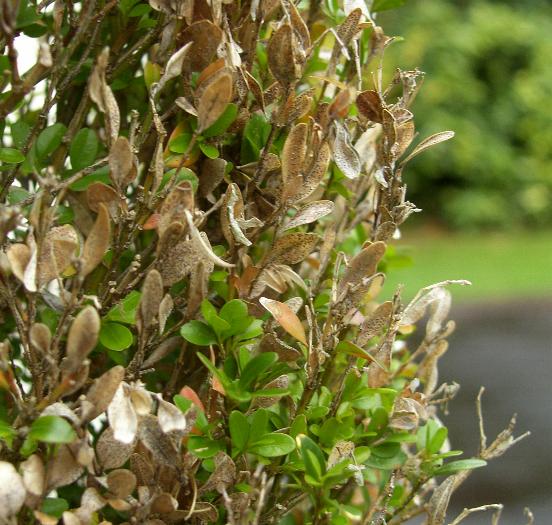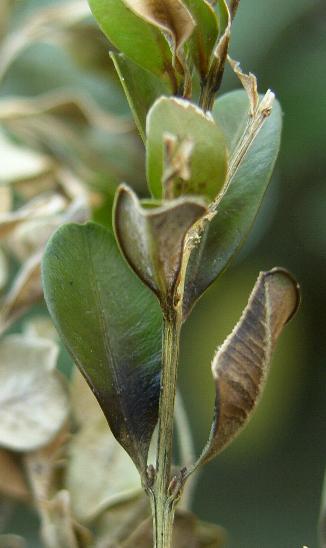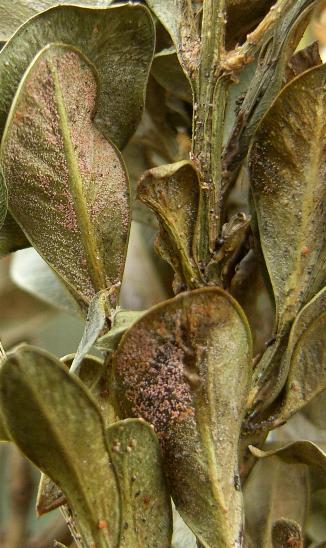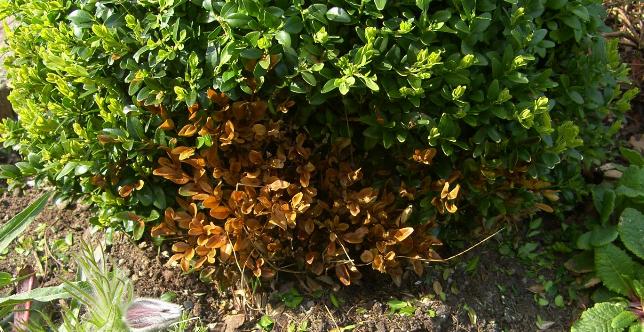
There are two organisms which cause Blight in the Genus Buxus; both are fungal and they can occur together. Volutella Blight has been around for many years. It is caused by Volutella buxi which is the asexual stage of the fungus Pseudonectria rousseliana. This results in browning of the leaves and dieback of branches leaving bare patches in hedges and topiary specimens. It spreads in wet humid conditions - pinkish spore-producing bodies appear on the undersides of leaves and asexual spores are carried in water splashes to new sites. Fallen leaves carry the disease over the winter and new spores are produced in the spring. They enter the plant through clipping cuts and other damage to leaves and stems.


The other Box Blight, which is more serious, has only been recognised in the British Isles since the mid 1990s, but is causing great concern. The fungus Cylindrocladium buxicola produces symptoms similar to Volutella with defoliated plants. The leaves develop dark brown spots which enlarge to effect all of the tissues, patches of greyish fungal growth appear on the underside and asexual spores (conidia) are soon released to spread the infection. Black streaks appear on the stems. The spores are capable of penetrating the cuticle so wounding is not necessary for infection to occur.
The disease requires moist conditions to thrive - the asexual spores die in dry conditions. Viable spores have been found in decomposing leaves after nearly a year, so any debris should be burnt if possible - never add to the compost heap.
Treatment Dog urine damage to the base of a box bush. Not all brown or dead patches are caused by Box Blight, it could be caused by dog or tom cat urine if it is at the bottom of the plant, as they 'territory mark' the same spot repeatedly and this scorches the leaves. If the dead area occurs suddenly and not gradually this could be the reason - the blight tends to develop slowly. Buxus sempervirens 'Handsworthiensis' with larger fleshier leaves is said to be resistant or recovers well if affected. Alternative plants to use for topiary and parterres are the Box-leaved Holly (Ilex Crenata), Box-Leaf Honeysuckle (Lonicera nitida), Euonymus fortunei, Pittisporum, Myrtle (Myrtus communis), Sweet Box (Sarcococca confusa) or Yew (Taxus baccata). |
A recently discovered threat causing defoliation to Box (Boxwood) is the Box Tree Caterpillar (Cydalima perspectalis) the larva of a moth native to east Asia which can strip the foliage. It first appeared in Europe in 2007, first spotted in Buckinghamshire and Hertfordshire, the caterpillars are now throughout the British Isles. They are similar in colour to the Large Cabbage White Butterfly larvae with a black head. Another symptom which may be spotted first is webbing among the foliage. Pick off the caterpillars or prune out infested material with defoliation and webbing. There is a biological control which uses a strain of the microorganism Bacillus Thuringiensis subspecies Aizawai (Bta), (trade name XenTari). Insecticides containing pyrethrum, deltamethrin or cyhalothrin may work. Any sightings should be reported to the RHS at Wisley.
Back to article on Plant Diseases